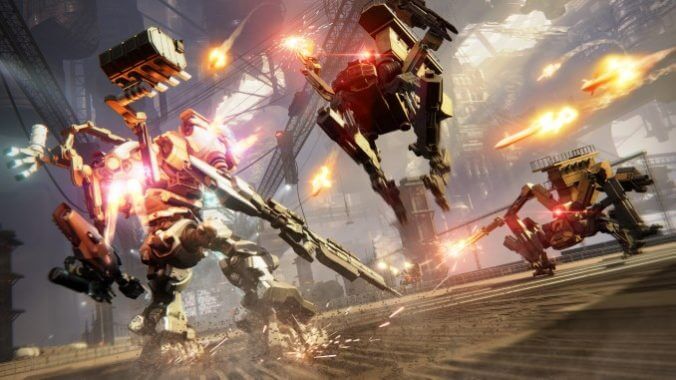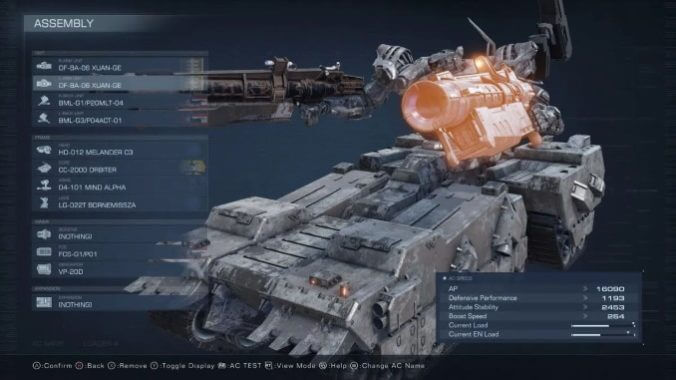
This week Paste‘s games team looks back at their favorite gaming moments of 2023. Today Paste‘s assistant TV editor and games contributor Elijah Gonzalez looks at Armored Core VI: Fires of Rubicon‘s overwhelming and exhilarating customization options.
Going into Armored Core VI: Fires of Rubicon, I wasn’t quite sure what to expect. Like many, I jumped on the FromSoftware bandwagon with the Souls titles, and while I had heard murmurings about their mecha franchise from its legion of frighteningly devoted fans, the main points that seeped in were jokes about how these games are so high-speed you needed to hold the controller backward to press buttons fast enough and that a good percentage of players spent more time in the garage tuning their rigs than actually piloting them.
When I finally got a taste of the series with its latest entry, I wasn’t terribly surprised to find its battles as frenetic as this first bit implied. After all, what convinced me to check this one out was seeing a clip of a Core dancing around hails of bullets at a speed that seemed more fit for a fighter jet than a giant robot as it cleaved a foe in two with a laser sword. However, what I didn’t expect was how deeply I’d fall for crafting the war machine of my dreams as I spent hours planning out and testing these creations like a chrome-obsessed Dr. Frankenstein.
A central tenet of these games is that they prioritize heavy degrees of mech customization, allowing you to combine parts from different makes and models. In Armored Core VI, you can select pieces for the frame (core, head, arms, and legs), internal machinery (boosters, generator, and fire control system), and weapons (two arm slots and two shoulder slots). These elements aren’t just cosmetic, and each influences a long list of stats such as weight, energy capacity, varying types of defense, booster recovery, and much more. As you progress, you unlock an increasing number of parts you can buy in the store, which eventually results in a massive range of possible permutations.
Generally speaking, this type of freeform customizability usually isn’t the biggest draw for me, and although I can get pulled into the fun of building a character in RPGs and tactics titles, it’s usually not the primary reason I come to an experience. For instance, I mostly enjoyed how Sekiro did away with the role-playing systems of other Soulslikes, resulting in a more curated experience that helped make it one of the most finely honed action games ever made. When I first saw the extensive list of options for my Core in Fires of Rubicon, I imagined this would be something I’d set and forget while engaging with what I thought was the “real” reason I was there: the frantic mech combat.
But then, as I unlocked additional armaments, boosters, and frame parts, I started tinkering. I continued coming back and making minor adjustments, and sometimes bigger ones, until I eventually unlocked enough options to create meaningfully distinct Cores that aimed to achieve radically different goals. After I internalized what all the stats were and what they meant, I started to understand the underlying principles of what made a relatively cohesive AC. Each time I unlocked a new weapon, I’d head to the simulation room and test it against a digitized pilot, slotting it into a previous bot that was missing a little punch or envisioning entirely fresh possibilities. I’d compare and contrast, saving dozens of designs with small differences as I worked towards an ideal construction. In short, I became a mecha-obsessed sicko.

Multiple factors led me here. The initial event that set me down the path of a grease monkey came after I got shellacked by the first tough boss, Balteus. As my kinetic weapons failed to make a dent in its shields, I went back to the drawing board, eventually slotting in a pulse gun capable of tearing through its defense. A few deaths and many sword slashes later, this loadout delivered me to victory. This taught an important lesson: if a foe feels impossibly difficult, it’s probably because you brought the wrong tool for the job. From then on, whenever I met a sufficiently powerful rival, I’d adjust, frequently either pulling out an old design that fit the bill or creating a new one to counter this threat.
As implied by the need to craft specific Cores for certain tasks, these mechs can look and feel quite unique depending on how they’re assembled. The most crucial factor is the leg type, as this determines speed, total weight, and movement abilities, and I ended up putting together multiple versions of each paradigm. I created beefy tanks decked out with gatling guns and heavy ordinance to blow through formidable adversaries. I designed flying tetrapods that used high-capacity generators, vertical thrusters, and snipers or arcing projectiles to maximize my advantage in the skies. I had lightly armored bipeds with low loads that made the most of fast quick-boost reload times and a large energy capacity to lithely dash around the battlefield.
And my favorite was a beautifully dumb creation that cracked many tricky ACs in two, a melee-focused berserker that combined a laser lance with the deadly but usually woefully short-ranged pile bunker. Armed with boosters that increased melee distance, I would use the lance’s now massive thrust range to close the gap and stagger enemies before finishing off this dazed opponent with a blow from the pile bunker, further amplified by arms explicitly made to deliver point-blank strikes. Altogether, I created a massive catalog of creations, updating old designs after purchasing parts that better accomplished their design goals or dreaming up entirely new concepts after having a sudden eureka moment. I would cycle between these product lines to deal with particular match-ups or sometimes just for the sake of variety. All this was possible because you can sell parts back to the arms dealer for their full purchasing price, encouraging experimentation.
In other games, I’d probably feel at least partially guilty about trivializing bosses with my build because I’d worry that I “robbed” myself the joy of fully engaging with its systems. But here, making a broken mech often feels like it is the best way to engage with these systems. Each victory won from engineering skills was just as satisfying as one achieved through quick reflexes and memorizing enemy patterns. And being a FromSoft title, there were quite a few imposing big bads that required both these abilities to be utilized in tandem.
Although I initially thought people were joking about spending more time in Armored Core VI’s garage and combat simulator than deployed on the battlefield, this was close to the truth with my first playthrough. This run took nearly 30 hours, while my second was under 10. Sure, there were other factors for this discrepancy, like the slightly abridged nature of New Game+ or that I had greater familiarity with its mechanics and foes the second time around, but most of this difference came from having already thoroughly tested and cataloged nearly every part available. Instead of long engineering sessions, I mostly made minor adjustments.
This arc towards admiration of steel and circuity didn’t just point to well-designed game mechanics but a deeper harmony with this setting’s thoroughly dystopian corporatized hellscape. As I cut a bloody swathe through Rubicon, carrying out my role as an attack dog for Handler Walter and, by proxy, the exploitative companies that employed us, the money I earned with every kill took on an uncomfortable allure.
With every dead enemy, I got closer to a top-of-the-line engine or sharpshooting rifle I couldn’t previously afford. It didn’t matter that we were trampling on this planet in pursuit of a resource that had literally set the galaxy on fire or that our targets were people trying to defend their home from invaders in pinstripe suits. Caustic mission briefings and the ensuing gunfire became brief interludes before I got back to the shop, excited to integrate a new tool that could harvest lives more efficiently.
Much like the protagonist, C4-621, a character who never speaks because they’ve undergone horrific experimental surgery to render them more in sync with their Core, we’re slowly enshrouded in the cockpit, becoming increasingly in touch with our mech as we internalize every little intricacy of its function in the pursuit of perfected death-dealing. We never see a single human in Armored Core VI, at least not in the flesh. Similar to the player, they’ve been consumed by the machine.
Elijah Gonzalez is an assistant TV Editor for Paste Magazine. In addition to watching the latest on the small screen, he also loves videogames, film, and creating large lists of media he’ll probably never actually get to. You can follow him on Twitter @eli_gonzalez11.